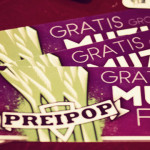How happy does the Top 2000 make you?
Neuroscientist Jacob Jolij has the answer. It might come as a surprise from someone who listens to the ‘bloody noise’ – his words – that is Metallica and plays in an indie rock band, but he does research into feel-good music. ‘I have done research into the connection between music and mood before, so it’s not unusual for companies to come to me with questions such as these’, Jolij explains.
‘I think a list with nothing but feel-good music would be exhausting’
This past September, British electronics company Alba had Jolij study a list of happy songs that 4,000 Britons play to make themselves feel better. After a review of the literature, it turned out that the song’s text, key and tempo influenced a person’s mood the most. Jolij: ‘There are many more aspects that might be important, but I had to limit myself to these three.
He put all the data into a computer model, which then came up with a lovely formula. This formula says that a song is happier when it has positive text elements, is written in a major key, and is around 150 beats a minute.
Happy Pink Floyd
With this in mind, Jolij studied the ten most popular Top 2000 songs of 2014. That list looked like this:
- Eagles – ‘Hotel California’
- Queen – ‘Bohemian Rhapsody’
- Led Zeppelin – ‘Stairway to Heaven’
- Deep Purple – ‘Child in Time’
- Boudewijn de Groot – ‘Avond’
- Pink Floyd – ‘Wish You Were Here’
- Billy Joel – ‘Piano Man’
- Pink Floyd – ‘Comfortably Numb’
- Pink Floyd – ‘Shine On You Crazy Diamond’
- Guns N’ Roses – ‘November Rain’
Almost all these songs are in a major key, so in that sense, they do not differ very much. Jolij: ‘The positive textual elements are also quite similar. The Pink Floyd songs have more beats per minute, so they score highest in the feel-good formula.’ Yet none of the top ten songs get a very high score: ‘Mainly dance songs score high on the Jolij Feel Good Index, and that is not what these songs are. The feel-good effect is really achieved by very basic processes: when you put on a fast song, you start moving. And moving makes you feel better.’
A British formula
Jolij does add a proviso to his findings: ‘The formula is based on the opinions of Britons who are 40 years old and over, so the criteria might be different in the Netherlands.’ However, the neuroscientist does not expect much difference: ‘Tempo and key will always be important, no matter what country you’re in. But I am currently working on researching those differences.’
The current formula certainly does not make the top ten sound very happy. ‘It goes to show that a good song doesn’t always have to be a feel-good song’, he jokes. It is therefore his recommendation not to assemble the Top 2000 list on the basis of his formula: ‘A list consisting of nothing but feel-good music is probably quite exhausting.’
If you compare it to food, the formula has an effect similar to a Big Mac: something that makes you really happy really quickly for a short period of time. Jolij: ‘Sad songs can also make you feel better or offer support.’ He thinks this year’s number one is a good example: ‘With ‘Imagine’, I think it’s the text and the message that make the difference. This song, but also many other classics, such as ‘Bohemian Rhapsody’ or ‘Stairway to Heaven’, play to much more complex processes. They are not easily expressed through a formula.’ So we will not ring in the New Year dancing, but ‘Imagine’ brings us something else: hope for 2016.






